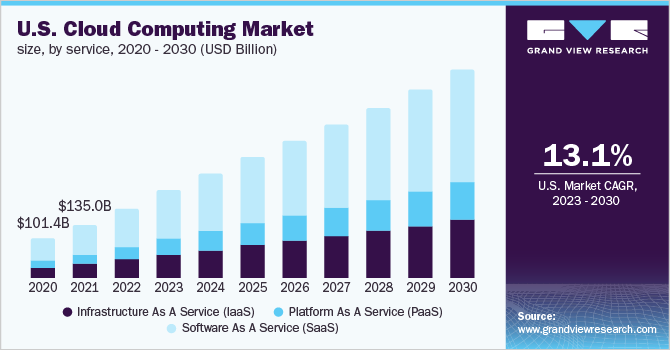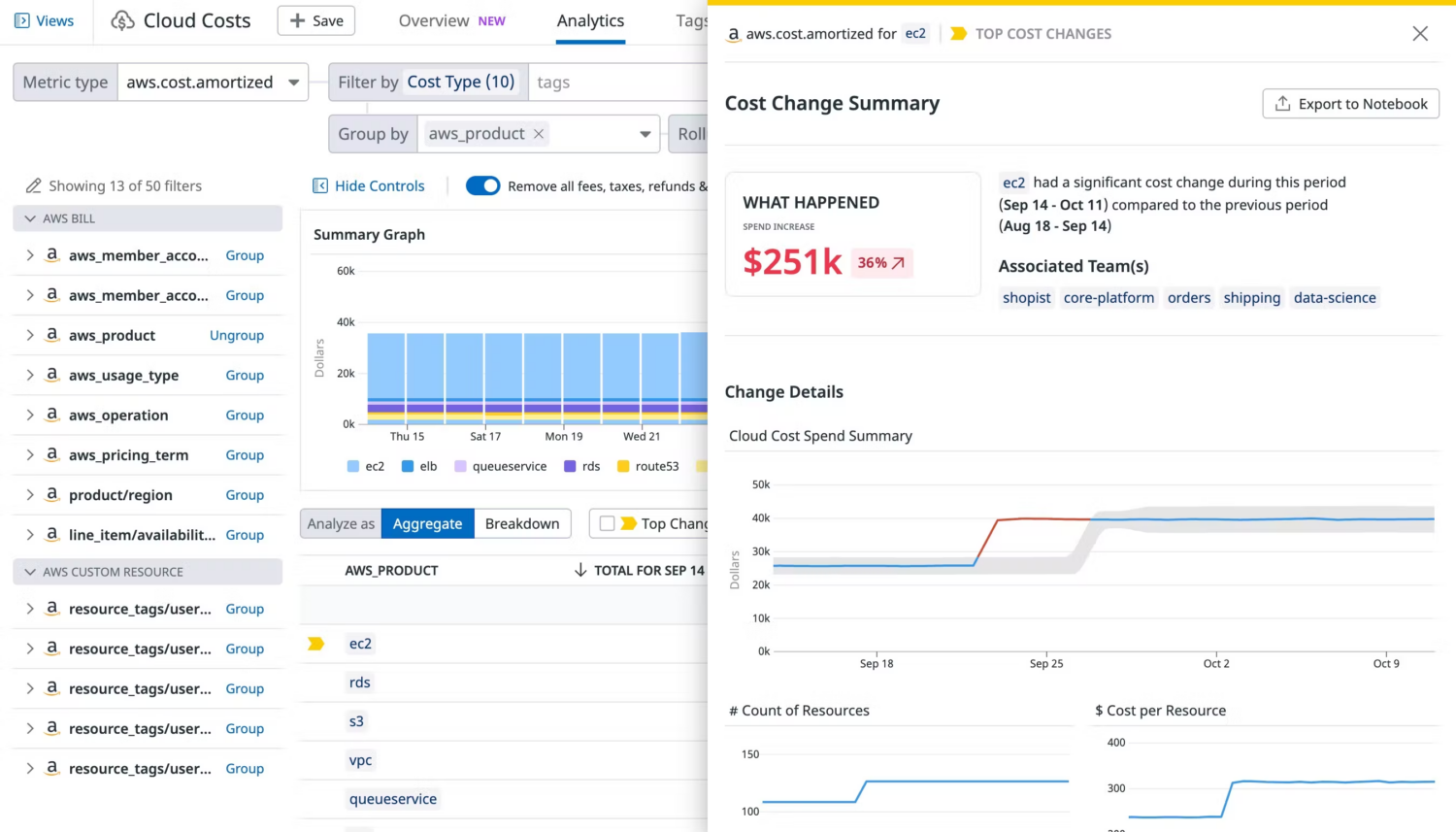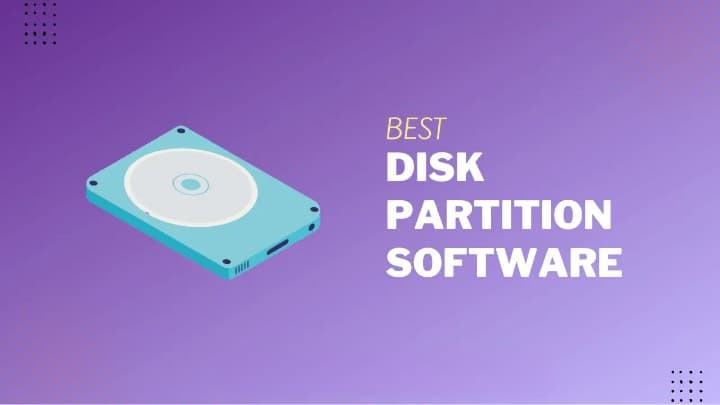
Companies can optimize their cloud spending, identify inefficiencies, and project their cloud costs with a cloud cost management (CCM) tool that provides real-time insight into cloud resources, consumption patterns, and cost allocation. Provides time exposure.
How is Cloud Cost Management (CCM) so important?
Most firms have moved to use cloud infrastructure in recent years because of its many benefits, including lower costs, increased efficiency, scalability, centralization, business continuity, security, and more.
According to a Grandview research report, the worldwide cloud computing industry, which was expected to generate revenue of USD 483.98 billion in 2022, will reach USD 1,554.94 billion by 2030.
To put it briefly, cloud computing is changing how companies of all sizes, from SMBs to multinationals, do business. The rising cost of cloud computing is one of the new problems that these benefits bring with them.
Cloud computing is becoming more and more expensive, and not knowing what to expect can have serious financial consequences.
Ineffective cloud cost management can result in unexpected cost increases, overspending on unused resources, or even poor performance.
According to data from Cloudzero, only 3 in 10 firms know exactly where their cloud spending is going, and 49% of organizations report that cloud costs are higher than they realize.
To optimize their cloud infrastructure and control costs, enterprises should implement cloud cost management as a cost management technique. Organizations use CCM to reduce cloud infrastructure costs by optimizing cloud utilization and increasing productivity.
Because it enables businesses of all sizes to maximize their cloud usage by identifying cost-saving opportunities and preventing unexpected charges, effective cloud cost management is critical. A company can increase overall revenue and forecast future costs and consumption by using a cloud cost management approach.
Companies that have a greater understanding of their cloud costs and usage can enforce accountability across the organization and maximize the performance of their cloud technology.
Benefits of Cloud Cost Management (CCM)
Due to the scalability, flexibility and affordability of cloud computing, its use is increasing tenfold across various industries. But with the cloud’s benefits come new challenges, especially when it comes to controlling costs. Here is when cloud cost management solutions come in handy.
Following are some of the key benefits of using a cloud cost management solution:
- CCM’s ability to accurately estimate and manage costs is one of its greatest advantages. This helps companies reduce unnecessary costs and optimize their cloud spending.
- Businesses can use CCM solutions to measure expenses and consumption to better manage their cloud resources and budgets.
- Cloud cost management tools can also yield cost-saving insights, such as identifying underutilized resources or opportunities to take advantage of cheaper cloud services.
- By optimizing resource utilization and providing comprehensive cost analysis, CCM can help businesses make informed decisions about their cloud deployments.
- Companies can use CCM to identify cost-saving opportunities, avoid unplanned expenses and ultimately generate profits.
In summary, CCM tools help with cloud usage forecasts, scalability planning, increased efficiency, delivery of compliance-oriented solutions, adoption of security best practices, and significant cost savings.
How do I Choose the Best Cloud Cost Management Tools?
Maintaining cloud spending is dynamic in nature due to constant changes in corporate objectives, technology, application requirements, cloud pricing, and many other aspects. For cloud cost optimization to be successful, accurate metrics, analytics, and automation are essential due to the sheer complexity of cloud environments.
Following are a few features of cloud cost management solutions that will make the process easier;
- AI and automation-powered platform
- Determine idle and underutilized cloud resources.
- Cloud usage can be predicted at different granularities.
- Measure services accurately.
- Full reporting
- Clear and comprehensive cost analysis
- Use Spot Instances and Reserved Instances.
- Watch for cost irregularities.
- Use appropriate storage options.
- Able to present cost analysis throughout the SDLC
- Determine and minimize software license costs.
- Notifications when costs are exceeded.
- Budget and monitor miscellaneous expenses.
- Notifications when resource usage is exceeded.
The above elements will undoubtedly help you choose the best cost-management solution for your cloud environment. However, as our society becomes more technologically advanced, these solutions are likely to disappear.
1) Cloudzero
With the use of machine learning (ML) and advanced analytics, CloudZero’s platform enables enterprises to gain deep insight into their cloud spend and insight into the overall cloud infrastructure, as well as individual service usage and reservations and enables a thorough and detailed understanding of underutilization.
Cloudzero is trusted by cloud-based businesses like Malwarebytes, Ping Identity, and Rapid7.
The technology enables better unit economics and efficient spending by offering end-to-end visibility over cloud resources and costs.
By bringing together engineering and finance teams around KPIs such as cost per product, Cloudzero enables engineers to develop solutions that are efficient, targeted and economical. The finance team receives information about the actions taken to monitor the implemented solutions within the allocated budget.
Its tailored solutions provide the greatest outcomes for businesses of all shapes and sizes. With its range of cost management tools, clients can find inefficiencies and cut costs.
Features
- Tagging and allocating advance costs to short-term business goals.
- Compute COGS, unit costs, customer costs, Kubernetes costs, and overhead costs.
- Focuses multiple teams—engineering, development, finance, and others—to prevent overspending around a particular expense.
- To preserve engineering cost accountability, finance teams have the authority to approve and disallow cloud finance.
It is the ideal option for businesses seeking cost reduction, cloud infrastructure optimization, and operational success due to its flexible features and continuous innovation. If you want to evaluate your current cloud cost management, you can visit its free evaluation website.
2) Apptio
Over 60% of Fortune 100 companies use Apptio for cloud cost control and other cloud solutions. Through effective cloud cost management, facilitating team ownership, and appropriate cost allocation, Apptio helps companies achieve exceptional business results.
Apptio improves the business value of your cloud spending with accountability and visibility.
Forrester Wave has named Apptio Cloudability as the top provider of cloud cost management and optimization (CCMO) services for Q3 2022. Performance, cloud visibility, pricing, and support for cloud platforms are among the standards it’s built on.
Apptio evaluates every stage of the FinOps framework’s lifecycle, including benchmark performance analysis, fully loaded cost understanding, and utilization and rate optimization. According to the website, users claim a 30% reduction in cloud rates, a 100% reduction in cloud allocation fees, and 90% reservation coverage.
Features
- Highlights underutilized and underutilized resources and adjusts their size to continuously optimize cloud utilization and costs.
- Accurately allocates cloud costs across cost centers, roles, business divisions and products.
- By showing you where money is being spent, cloud cost visibility helps you stay within your budget.
- Cloud engineers can quickly assess, plan and manage migrations to the public cloud using our Cloudability Shift tool.
The latest Apptio Cloud cost management technology optimizes cloud resources for cost, speed, and quality and covers every aspect of cloud cost optimization.
3) ManageEngine Cloud Spend
By adopting best practices like implementing chargeback, capacity reservation, and resource entitlement, ManageEngine Cloud Spend helps you optimize your cloud spend. Simply put, it improves cloud cost awareness and helps you regain control of your spending.
ManageEngine says a 33% reduction in costs and a 60% reduction in time spent monitoring cloud bills is the result of its more than fifty best cloud costing practices.
Business units (BUs) can be created using Cloudspend to track cost accountability at different levels. It’s helpful to drill down to get a complete overview of each team’s cloud spend and its tracking feature.
Features
- User-defined and automatically generated tags to isolate and evaluate segments of your cloud spend.
- It is possible to track expenses for multiple teams, projects, and clients.
- Forecasting based on past data and gaining knowledge to stay on course to meet financial goals.
- Monitor accumulated costs to evaluate cost plans, consumption, and performance.
ManageEngine CloudSpend helps businesses reduce waste and make efficient use of cloud resources. ManageEngine facilitates the monitoring, analysis and management of Azure and AWS cloud costs.
You can test CloudSpend for free for thirty days, after which you can upgrade to a premium plan based on your cloud usage charges. You can use it for free up to a monthly cloud charge of $3,000 or more.
4) Virtana
Managing cloud costs is a difficult and complex task for businesses of all sizes. The cost of these services has increased with the increase in the use of cloud computing. This is where Virtana Cloud overcomes cost.
It offers a comprehensive solution that helps companies identify unnecessary costs, optimize resource allocation and monitor cloud usage.
Virtana Cloud Cost Management optimizes cost, capacity and efficiency to help enterprises manage hybrid cloud IT infrastructure continuously and in real-time.
Additionally, the program provides cost optimization, helping businesses create reliable cloud investment reports and more effectively track their financial constraints.
Because of its real-time data collection and analytics, the company is able to meet SLAs and keep costs under control. With Virtana, you can uncover ways to reduce costs, control your cloud costs through its unified approach to resource allocation and usage, and set up automated processes for better results. are
Features
- Active identification of available resources.
- Optimizing cloud resource scheduling to meet specific business objectives.
- Get a comprehensive understanding of your hybrid cloud costs.
- Rightsizing recommendations combined with automatic instance optimization.
Globally, businesses are seeing significant cost improvements.
Virtana’s technology provides efficient and effective cloud computing with improved transparency and visibility across its entire cloud infrastructure.
5) Datadog
Datadog, a cloud monitoring application, offers several ways to reduce unnecessary cloud costs. With its cloud cost management tools, customers can more easily keep tabs on and segment their cloud costs, forecast cost trends, and identify anomalies to increase efficiency.
The Datadog platform provides transparent insight into cloud costs and helps optimize cloud infrastructure by detecting downsizing or resizing of cloud workloads. All things considered, this is a helpful tool that provides businesses of all sizes with detailed insight into the costs associated with using cloud resources.
Features
- Detailed cost analysis per cloud environment granularity.
- Personal dashboards to view cloud computing costs.
- Determines the most important cost variables in cloud systems by teams, services, etc.
- Dashboards for FinOps, Engineering, and other teams to communicate spend.
With DatadogHQ, a complete solution, cloud service providers can optimize their costs in a multi-cloud environment. Due to its real-time monitoring and optimization capabilities, transactions can be done smoothly.
Comprehensive data to ensure they are not overpaying or overprovisioning.
You can test the full version for free for a period of 14 days.
6) Google Cloud
If you use Google Cloud, you can monitor, control and optimize your cloud costs with its cloud cost management platform. By implementing these technologies, you can monitor cloud resource usage, create budget alerts, monitor expenses, forecast trends and more.
Alternatively, by using these optimization strategies, you will be able to reduce your cloud computing costs.
With its insightful advice, Google’s dedicated cost management platform optimizes your cloud costs by providing a range of data to help you analyze current cost trends.
Because of accurate cost allocation, managers can easily identify areas where total costs can be reduced and how the overall cloud infrastructure should be optimized.
Features
- Great tips for increasing effectiveness and immediate cost savings.
- Resource classification to manage cost distribution through granular access control.
- Quota limits and billing access controls are used to manage costs and avoid unexpected usage surges.
- The purpose of budget alerts and notifications is to alert you when expenses exceed a predetermined limit and limit spending to avoid unexpected expenses.
- Ability to export billing information to BigQuery for in-depth cost analysis.
SMBs and large enterprises can unlock cost savings, improve cloud governance, and ultimately drive company growth with the help of Google Cloud’s cost management platform.
7) Harness
Harness is a dependable and strong software distribution platform that aids businesses in automating the deployment of code changes in many contexts. One of Harness’s core platforms is its cloud cast management system.
The platform offers a comprehensive understanding of the amount a company spends on cloud services from various cloud providers.
Businesses can reduce their cloud costs by up to 70% by using Harness Cloud’s cost control software. It achieves this by identifying and removing unnecessary cloud costs in addition to automated processes.
The platform emphasizes proactive automation to reduce overhead while offering complete visibility into your cloud spend.
Clients can get the most out of the cloud and find any inefficient or underutilized resources that could drive up costs with this technology.
All of the main cloud service providers, including Microsoft Azure, AWS, and Google Cloud Platform, are compatible with this cloud cost management application.
Features
- Reduce infrastructure costs and increase resource availability with Kubernetes cluster automation.
- With cloud auto-stopping, idle cloud resource time can be effectively managed.
- Fully customizable dashboard to check cost information for projects.
- Automation of labeling and allocation of resources.
Using Harness, businesses can monitor and evaluate their cloud spend, set cost limits and alerts, and maximize their usage efficiency. Ultimately, Harness helps companies reduce their cloud costs, achieve more predictable spending plans, and boost expansion and profitability.
You can use the free platform for up to 250k cloud spend, or you can upgrade to Team or Enterprise subscriptions for unlimited cloud spend.
8) nOps
Are you looking to reduce your monthly cloud subscription and use Amazon Cloud Services (AWS) instead? Then, nOps can save the day for you. According to the website, AWS costs can be reduced by up to 50%.
Within the Amazon Partner Network, nOps holds Advanced Technology Partner status. It offers additional security, reliability, and compliance benefits while helping businesses manage and operate AWS infrastructure in a cost-optimized manner.
With automation tools and better visibility into AWS pricing, nOps is an award-winning platform that helps engineers monitor, evaluate, and optimize complex cloud infrastructure.
Because it operates on autopilot, engineers can focus more on innovation and spend less time on manual tasks such as fixing inefficiencies to reduce costs.
Features
- Reserved Instances (RIs) are automatically bought and sold in response to infrastructure changes.
- An advanced system to identify and shut down idle resources to reduce cloud bills.
- Certified SOC2 Type 2 Ops Team.
- It offers an easy, risk-free way to reduce how much you pay for EC2/Fargate/RDS.
AWS management software that automates tasks is offered by innovative tech startup nOPS in an effort to save cloud costs. Through the new pricing mechanism, the business charges a percentage of the customer’s savings.
9) Zesty
Thousands of businesses worldwide rely on Zesty, an AI-powered cloud infrastructure management platform, to meet changing business needs.
With its advanced technology, which predicts traffic patterns, cloud resources can be optimized and cloud costs can be reduced. Commitment Manager for C2 and Zesty Disk for block storage auto-scaling are its two available options.
In addition to helping companies optimize resources for optimal performance during business hours, the Zesty platform helps prevent overspending on resources they don’t need during non-business hours.
Zesty Automation reduces cloud costs and ensures that customers receive uninterrupted service even during traffic spikes and helps businesses with real-time demand analysis and cloud resource deployment according to business needs. do
Features
- Real-time analytics and monitoring enable businesses to make well-informed decisions and maximize their resources.
- AWS RI can be automatically bought and sold to reduce costs by up to 60%.
- By dynamically reducing and increasing block storage size, you can save up to 70% on block storage on AWS and Azure.
- Reduces risk by guaranteeing the buyback of any RIs that are overprovided.
The Zesty platform is built keeping in mind the dynamic, ever-changing needs of cloud services, ensuring optimal performance without breaking the bank. Zesty ensures that your website or application is constantly working at its best and at the lowest cost.
Customers don’t have to pay Zesti anything if they don’t save money because of the company’s results-based pricing strategy. You can use its free version for visibility and monitoring.
ALSO SEE:
- Cloud PC
- Free CRM Tools
- Cloud Gaming Services
- Windows VPS Hosting
- AI-Powered Finance Tools
- Healthcare CRM Software
Final Remarks
Cloud cost management solutions help businesses optimize their cloud spend. Each workload in a cloud deployment has specific requirements, which may vary over time.
To reduce cloud costs, you should set performance thresholds for each activity based on actual operational KPIs and domain expertise. Reducing costs and maintaining performance requirements are the two main goals of cloud optimization.
Cloud cost management should be a top priority for companies that have adopted cloud technology to gain better control over waste and overspending.
Your cloud environment will benefit from these technologies. Cloud infrastructure enables businesses to maximize cost-effectiveness, meet business objectives, and make informed decisions about cloud spending.




